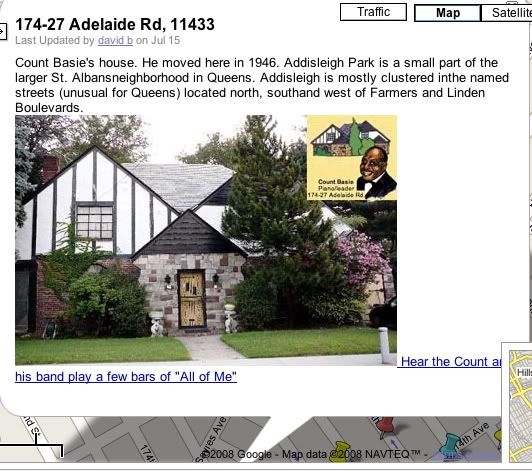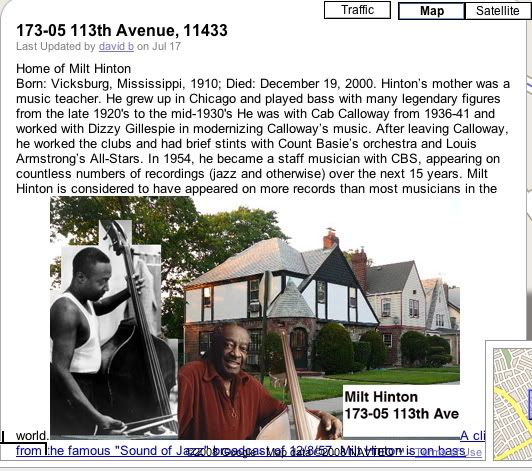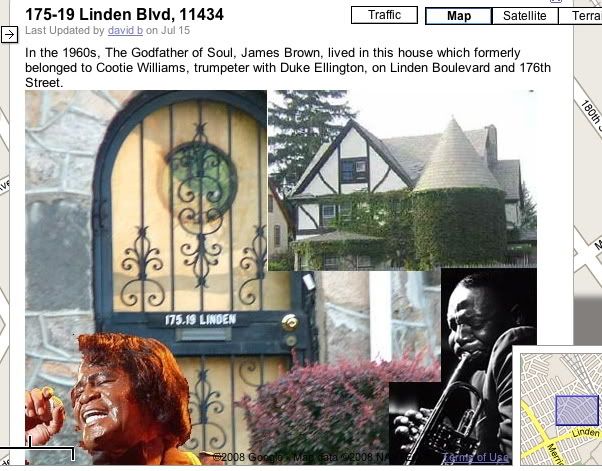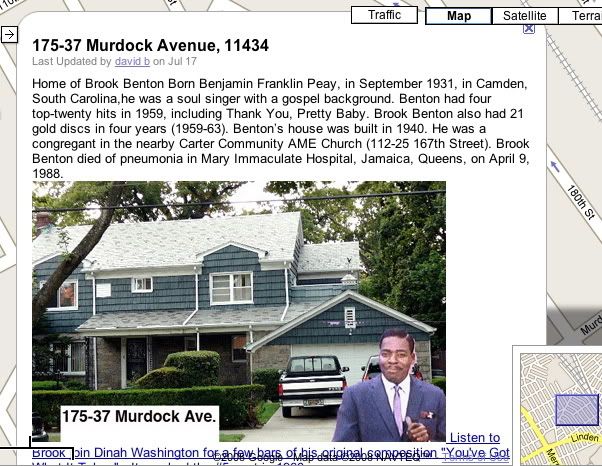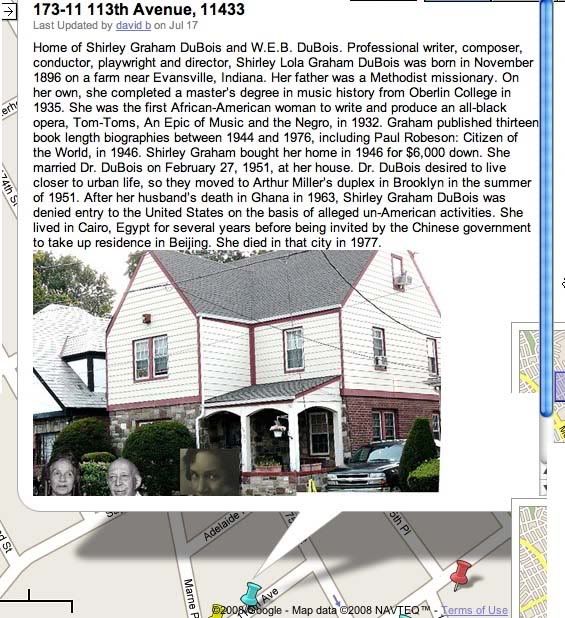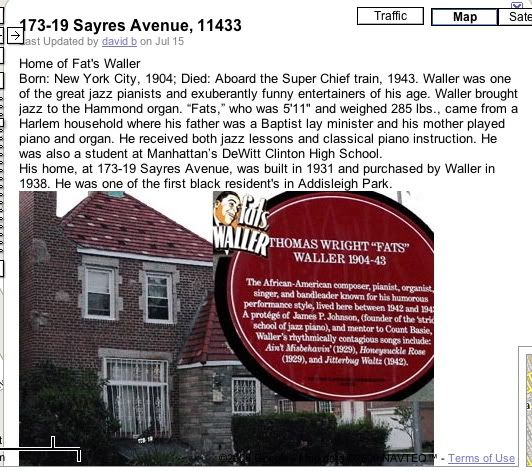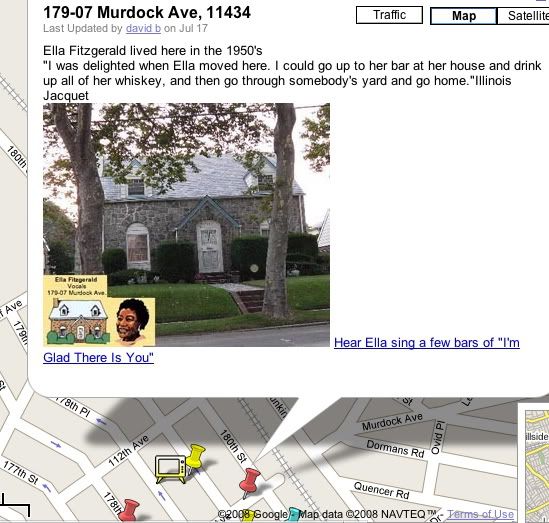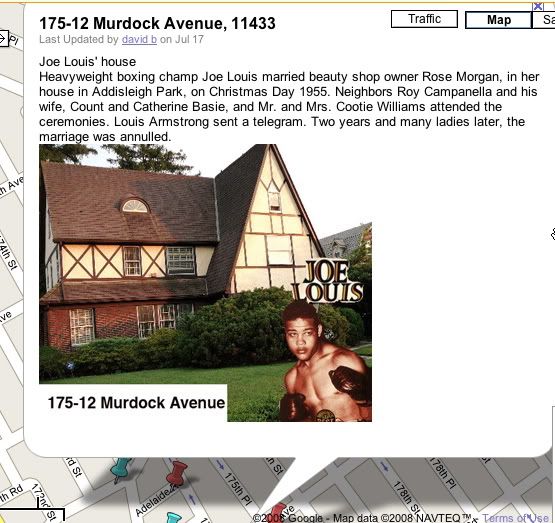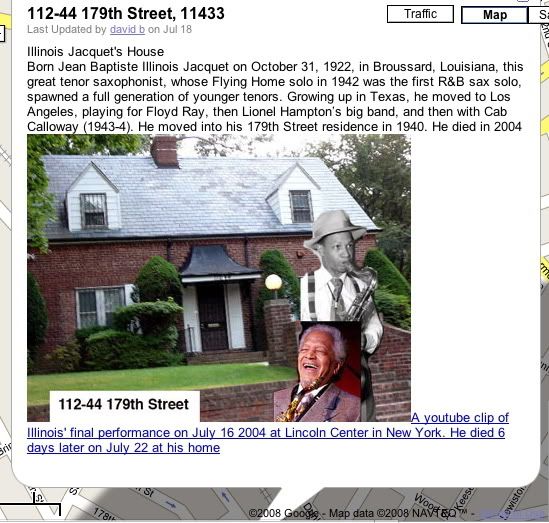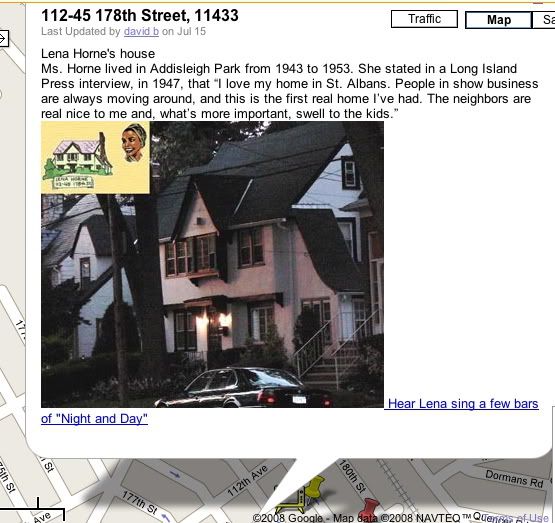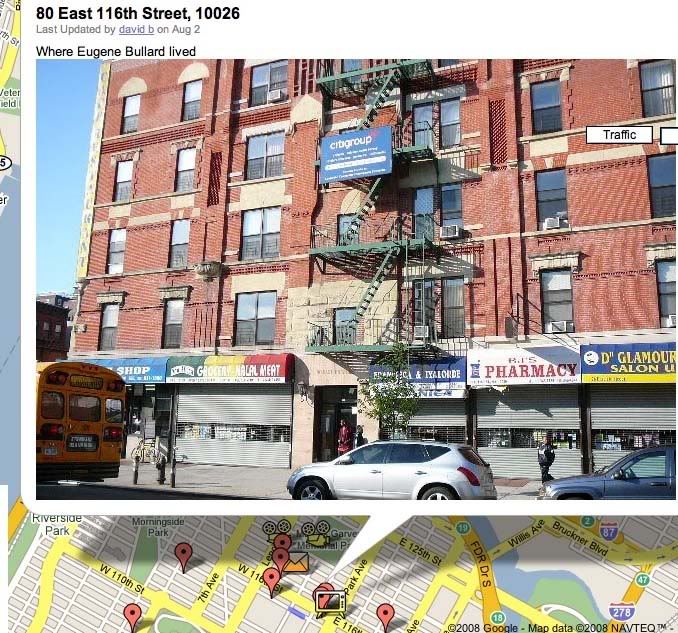Maritcha Homes
Maritcha was an assistant principal at PS 83.
Sunday, March 7, 2010
Maritcha Lyons' Addresses In Brooklyn
Posted by David Ballela at 10:20 PM 0 comments
Labels: google maps, Maritcha Lyons
Saturday, March 1, 2008
Google Maps: Count Basie
Posted by David Ballela at 5:18 PM 0 comments
Labels: count basie, google maps, Queens
Google Maps: Milt Hinton
Posted by David Ballela at 5:17 PM 0 comments
Labels: google maps, milt hinton, Queens
Google Maps: James Brown And Cootie Williams
Posted by David Ballela at 2:17 PM 0 comments
Labels: cootie williams, google maps, james brown, Queens
Google Maps: Brook Benton
Posted by David Ballela at 2:15 PM 0 comments
Labels: brook benton, google maps, Queens
Google Maps: W.E.B. Dubois
Posted by David Ballela at 2:06 PM 0 comments
Labels: google maps, Queens, W.E.B. DuBois
Google Maps: Fats Waller
Posted by David Ballela at 10:38 AM 0 comments
Labels: fats waller, google maps, Queens
Friday, February 29, 2008
Google Maps: Ella Fitzgerald
Posted by David Ballela at 8:09 PM 0 comments
Labels: ella fitzgerald, google maps, Queens
Google Maps: Roy Campenella
Posted by David Ballela at 8:03 PM 0 comments
Labels: google maps, Queens, roy campenella
Google Maps: Illinois Jacquet
Posted by David Ballela at 8:49 AM 0 comments
Labels: google maps, illinois jacquet, Queens
Google Maps: Lena Horne
Posted by David Ballela at 8:40 AM 0 comments
Labels: google maps, lena horne, Queens
Google Maps: Jackie Robinson
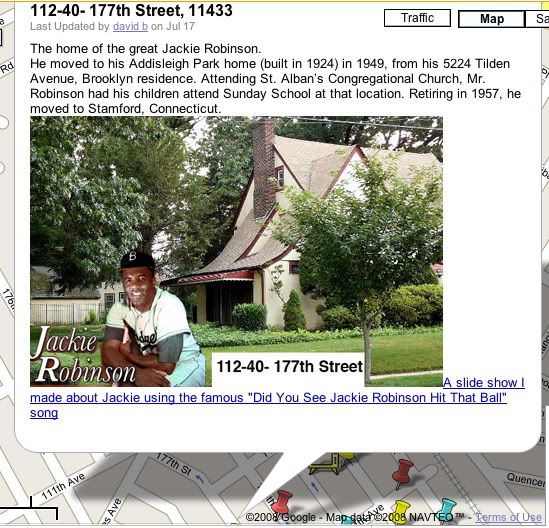
from My Queen's Jazz Trail
After living in apartments In Brooklyn, Jackie bought this home. Later he and his family moved to Stamford, Connecticut
Posted by David Ballela at 8:33 AM 0 comments
Labels: google maps, Jackie Robinson, Queens
Addisleigh Park In Queens
a slide show I made (the original is bigger and more viewable) of many of the historic homes I pinpointed on my Queens Jazz Trail Map. The nusic is "Flying Home" by the Lionel Hampton band featuring former Addisleigh Park resident and great tenor sax player Illinois Jacquet
from a great nyc history site forgotten-ny
Southern Queens' ascendance as a mecca for jazz musicians began in 1923 when Clarence Williams, a successful musician and entrepreneur from Plaquemine, Louisiana, purchased a home and eight lots at 171-37 108th Avenue. Anticipating the increasing popularity of jazz in the north, Williams moved first to Chicago in 1920 and then to New York with his wife, singer Eva Taylor, in 1923. Desiring open spaces reminiscent of his upbringing in the Louisiana delta, Williams made his home in Queens. He would be the first in a lengthy line of jazz musicians to come to southern Queens.
Addisleigh Park is a small part of the larger St. Albans neighborhood in Queens. Addisleigh is mostly clustered in the named streets (unusual for Queens) located north, south and west of Farmers and Linden Boulevards.
There are precious few memorials to St. Albans/Addisleigh Park's jazz heritage. This now-fading mural on the northern side of Linden Boulevard as it passes under the Long Island Railroad depicts many of the jazz and entertainment giants who resided here.
Having grown up in New Jersey, Count Basie arrived in NYC in 1923 and joined Fats Waller's (see below) band as an organist in 1924. After playing with Benny Moten's band, forging a new swing-based sound in Kansas City in 1927, he returned to the big apple in 1936 as the leader of the Count Basie Orchestra, which featured Lester Young and Herschell Evans on sax, trumpeters Buck Clayton and Harry Edison and vocalists Billie Holiday, Jimmy Rushing and Helen Humes. Their residence at the Woodside Hotel in Harlem inspired 1938's "Jumpin' at the Woodside."
Count Basie's home on Adelaide Road and 175th Street, St. Albans
In the 50s, Basie formed a new band that included the new sound of bebop and more blues-y elements. Basie's pop hits include "One O'Clock Jump," "Blue Skies," and the #1 "Open the Door, Richard!" in 1947; in 1963 he enjoyed a Top Five album with Frank Sinatra, "Sinatra-Basie." Count Basie moved to the new neighborhood of Addisleigh Park in 1946.
ELLA FITZGERALD (1918-1996)
"Among all of us who sing, Ella was the best". -- Johnny Mathis
"I never knew how good our songs were until I heard Ella Fitzgerald sing them."
--Ira Gershwin
Ella Fitzgerald performed for 58 years, won 13 Grammy Awards and sold in excess of 40 million records. "The First Lady of Song" was born in Newport News, VA, and was orphaned young in life. She was discovered in an amateur contest sponsored by Harlem's famed Apollo Theatre in 1934 and was soon the featured vocalist in Chick Webb's band.
Ella lived on Murdock Avenue between 179th and 180th Street. She moved to Addisleigh Park in the 1950s. "I was delighted when Ella moved here. I could go up to her bar at her house and drink up all of her whiskey, and then go through somebody's yard and go home."Illinois Jacquet
Ella enjoyed her first big smash in 1938 with "A-Tisket, a Tasket" and led Webb's band for three years after his death in 1939. After enjoying dozens of hits on the Decca label, including "I'm Making Believe" in 1944, "I Love You For Sentimental Reasons" in 1946 and "Baby, It's Cold Outside" with Louis Jordan in 1949, Ella moved on the the new Verve label in 1955 and reinterpreted classics by Cole Porter, Duke Ellington and Rodgers and Hart on albums featuring Nelson Riddle arrangements.
MILT HINTON (1910-2000)
The dean of jazz bassists, "The Judge" was born in Vicksburg, Mississippi and moved to Chicago with his family in 1921. After working through the 1920s a s afreelance musician with such legendary jazz artists including Zutty Singleton, Jabbo Smith, Eddie South, Erskine Tate, and Art Tatum, he joined Cab Calloway's band in 1936, remaining with Cab for 15 years. Milt Hinton lived at 113th Avenue and Marne Place.Hinton was a Queens resident from 1950 until his death in 2000.
Striking out on his own in the early 1950s, Hinton went on to play on thousands of recordings and toured extensively, performing with such giants as Louis Armstrong, Bing Crosby, Charles Mingus, John Coltrane, and even pop musicans such as Bette Midler and Paul McCartney. Milt Hinton was also an educator and author, teaching at Hunter and Baruch Colleges. He also became an exhibited photographer, having taken over 60,000 images from his years on the road; many were published in his his book "Bass Line."
Fats Waller was reportedly the first African American to live in Addisleigh Park. He resided at Sayres Avenue and 174th Street. His home had a built-in Hammond organ and a Steinway grand. His derby tilted rakishly to one side, Fats Waller plinked the 88s and dotted his playful, high-spirited jazz-pop songs with bawdy ad-libs. Waller, one of the 1930s' consummate crowd-pleasers, was born in Greenwich Village in 1904, was playing piano by ear at age six, and at his reverend father's encouragement, learned violin, bass violin and organ. Waller got his professional start at 'rent parties' (where admission was charged to help out with rent payments) and vaudeville. In 1927, he collaborated on his first hit show, "Keep Shufflin'", and his next show, "Hot Chocolates" contained his first big hit, "Ain't Misbehavin.'" Waller went on to score and perform in dozens of shows. His biggest hit, "It's a Sin to Tell a Lie", came in 1936, and he wrote and performed time-tested classics like "Honeysuckle Rose," The Joint Is Jumpin,'" and "Lulu's Back in Town." Waller suffered from drinking and overweight problems his entire life. He also considered himself a serious musician, but racism in the period prevented him from realizing these ambitions. Soon after finishing work in "Stormy Weather" in 1943 he collapsed and died of bronchial pneumonia.
LENA HORNE (1917-)
Lena Horne was born in Brooklyn in 1917 and has been performing since she was a teenager. She danced and later sung at the Cotton Club beginning in 1933 and made her first recordings in 1937 with Teddy Wilson's orchestra. She joined Charlie Barnet's orchestra in 1940, and while Barnet's behavior was exemplary (he was one of the first white bandleaders to hire African Americans) she tired of the draining segregation and racism that was such a constant durng that time. Upon signing with MGM in 1940, she shrewdly had a clause written in that prevented her from depicting domestics, in a jungle native role, or other cliché images. Her appearance in 1943's Stormy Weather was a sensation; her rendition of the title song was her biggest hit and remains her signature song. Lena Horne left Hollywood in the early fifties to concentrate on her singing. Like many of her contemporaries, Lena Horne resided at 178th Street between 112th Avenue and Murdock Avenue beginning in the 1940s. During the Joe McCarthy era, she was blacklisted for her left-wing associations, but in 1956 she was taken off the list and resumed her career. She found great success during the sixties and seventies. In 1981, she appeared on Broadway in her own show, Lena Horne: The Lady and Her Music, which became the longest-running one-woman show in the history of Broadway. She continues recording to this day. Lena Horne lives in New York City.
Saxophonist John Coltrane, who along with Charlie Parker is regarded by many fans as the greatest jazz performer in history, lived on Mexico Street near Quencer Road; Mercer Ellington, Duke's son, who took over the Ellington Orchestra after his father's death and wrote Duke's biography, lived on 175th Street near 113th Avenue; saxophonist Eddie "Lockjaw" Davis, Foch Boulevard near 171st Street; saxophonist Illinois Jacquet and his brother, trumpeter Russell Jacquet, in nearby houses on 179th Street near 112th Avenue; and saxophonist Earl Bostic, pianist/organist Wild Bill Davis, bassist Slam Stewart, trumpeter Cootie Williams, saxophonist Oliver Nelson, drummer James "Osie" Johnson, saxophonist Lester Young, and singer Rose Murphy also lived in St. Albans. In the 1960s, The Godfather of Soul, James Brown, lived in this house which formerly belonged to Bart Williams, trumpeter with Duke Ellington, on Linden Boulevard and 176th Street , and Brook Benton (who sung one of your webmaster's favorite songs, "A Rainy Night In Georgia", and wrote "A Lover's Question" and "The Stroll,") lived on Murdock Avenue near 175th Street.
Posted by David Ballela at 8:12 AM 0 comments
Labels: addisleigh park, count basie, ella fitzgerald, fats waller, google maps, illinois jacquet, james brown, john coltrane, lena horne, milt hinton, Queens
Google Maps: My Queens Jazz Trail Map
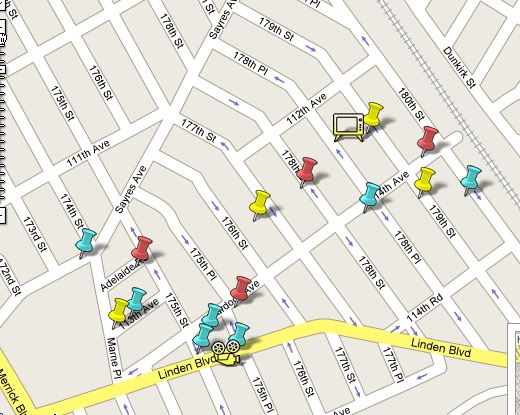
A screen shot of my Queen's Jazz Trail: A description
Homes of Jazz Greats and other notables in Queens,NY. With an assist from
Ephemera Press' great maps, the Central Queens Historical Association and Forgotten-NY.com. Bonus treat (those with red pins): hear a few bars of the music of these jazz greats or some video (yellow pins) Bonus also some panoramic movies (yellow movie icon)
Posted by David Ballela at 7:45 AM 0 comments
Labels: google maps, music, Queens
Thursday, February 28, 2008
Google Maps: Mary Lou Williams
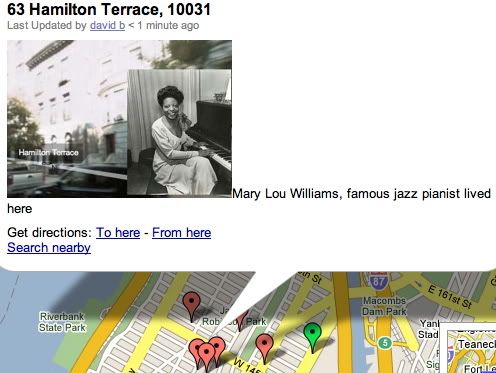
from my google map of harlem
Williams' 63 Hamilton Terrace apartment was famous in the mid-1940s as a salon where she imparted her knowledge of the jazz tradition to cutting-edge musicians.
from Rutgers' biographical site on Mary Lou Williams
"I'm the only living musician that has played all the eras," Mary Lou Williams confidently advised Marian McPartland in the debut 20 years ago of McPartland's acclaimed radio broadcast, Piano Jazz. "Other musicians lived through the eras and they never changed their styles."
She was right. Jazz fans and historians long ago concluded that Mary Lou Williams was the most important female jazz musician to emerge in the first three decades of jazz. William's multidimensional talents as an instrumentalist, arranger, and composer made her a star from her earliest days and, over the long haul, an equal to any musician successful in those endeavors. Her longevity as a top-flight jazz artist was extended because of her penchant for adapting to and influencing stylistic changes in the music.
In his autobiography, Music Is My Mistress, Duke Ellington wrote, "Mary Lou Williams is perpetually contemporary. Her writing and performing have always been a little ahead throughout her career. Her music retains, and maintains, a standard of quality that is timeless. She is like soul on soul."
Indeed, this process of constant reassessment and renewal she applied to her art is but one of the qualities that makes Williams (1910-81) a truly unique figure in the history of jazz. William's range of talents, summed up by what Ellington termed "beyond category," suggests both the richness and the ambiguity that have made assessing her role in jazz history challenging. Through the Williams Collection, researchers can, for the first time, more fully evaluate a pianist who was simultaneously a master of blues, boogie woogie, stride, swing, and be-bop. Her work as a composer and arranger for Andy Kirk's Twelve Clouds of Joy in the early 1930s reveals one of the earliest examples of a woman given due respect from her peers for her musicianship. William's career opens a window into the critically important Kansas City jazz scene that produced such giants as Count Basie, Lester Young, and Charlie Parker. Her stature in the jazz world is a natural attraction for scholars examining the lives not only of women jazz musicians, but also of twentieth-century African-American women and American history in a larger context.
Born Mary Elfrieda Scruggs on May 8, 1910, in Atlanta, Williams grew up in Pittsburgh, where her prodigious talents led to work as a hardscrabble professional traveling musician while still in her early teens. She came to prominence in the early 1930s with Kirk's Twelve Clouds of Joy, a leading southwestern territory swing band. Williams was not only the band's star soloist but also its chief arranger. Beyond the normal obstacles confronting African-Americans in that pre-civil rights era, she also had to contend with a musical milieu in which women instrumentalists were rare and women arranger/composers virtually non-existent. Billed as "The Lady Who Swings the Band," William's playing and writing were on a par with any of her more famous contemporaries. "Outside of Duke Ellington and Billy Strayhorn, there's no other composer she has to take a back seat to," David Berger, professor at Manhattan School of Music, told The Washington Post recently. In addition to her work for Andy Kirk, she composed and arranged for leading orchestras of the swing era: Duke Ellington, Cab Calloway, and Benny Goodman. These musical manuscripts are part of the Collection.
With her departure from the Kirk band in 1942, Williams settled in New York, where she opened her Harlem apartment to all types of musicians and was particularly encouraging to the experimentation of the young modernists. She helped to inspire and adapted to the revolutionary new style known as be-bop, which reduced many of her contemporaries to anachronisms, and also mentored many of the movement's founders, including Thelonious Monk, Bud Powell, Dizzy Gillespie, and Charlie Parker. (She crossed similar stylistic frontiers in 1977 when she performed a Carnegie Hall concert of duets with the avant-garde pianist Cecil Taylor.)
Her writing also continued to grow; along with Duke Ellington, she was a pioneer among jazz composers in producing extended works, such as the Zodiac Suite. In 1945, she debuted segments of the Suite on her weekly radio broadcast, Mary Lou Williams Piano Workshop, and performed three movements with the 70-piece New York Pops Orchestra during the June 1946 Carnegie Hall Pops Series. William's tours of England in 1952 and France in 1952, both widely covered in the European jazz press, place her in the tradition of Armstrong and Ellington two decades earlier in spreading jazz on the Continent.
In 1956, Williams underwent a spiritual conversion to Catholicism and gave up playing to concentrate on spiritual matters until reemerging in 1957 with a performance alongside Dizzy Gillespie at the Newport Jazz Festival. Compared to her rigorous schedule of touring over the previous 30 years, she played only sporadically over the next decade. She formed the Bel Canto Foundation to assist drug- and alcohol-dependent musicians in 1958. This initiative prefigured her founding of Cecilia Music, a publishing firm to release her compositions, and the establishment of Mary Records to issue her and other selected artists' recordings. Both of these events occurred in the early 1960s, when she also issued one of her later noteworthy recordings, the 1963 Mary Lou Williams Presents St. Martin de Porres.
Williams undertook several ambitious extended works during this period, including her 1971 composition Mary Lou's Mass, which was choreographed by Alvin Ailey and, in 1975, was performed during celebration of a Mass at St. Patrick's Cathedral. In 1977, her career undertook yet another significant turn. Duke University formalized William's role as an educator by appointing her as artist-in-residence, a position she held until her death in 1981. Duke permanently honored William's contributions by opening the Mary Lou Williams Center for Black Culture in September 1983 with an address by Nobel Prize winning author Toni Morrison.
Posted by David Ballela at 10:32 PM 0 comments
Labels: google maps, hamilton terrace/heights, harlem, mary lou williams
Tuesday, February 26, 2008
Google Maps: W.E.B. Dubois, Walter White, Thurgood Marshall
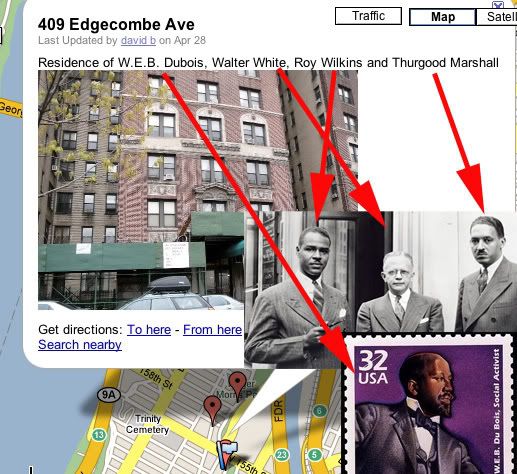
from my google map of harlem
In addition to Dubois, White, Marshall and Wilkins there were other notables that lived at 409 Edgecombe:
Julius Bledsoe - Singer
William Stanley Braithwaite - Poet and essayist
Aaron Douglas - Painter
Stephanie St. Clair
Posted by David Ballela at 10:17 PM 0 comments
Labels: google maps, Roy Wilkins, Thurgood Marshall, W.E.B. DuBois, Walter White
Google Maps: Paul Robeson And Count Basie

In addition to Robeson and Basie other notables lived at 555 Edgecombe:
Lena Horne - Singer and actress
Coleman Hawkins - Musician, saxophone player
Johnnie Hodges - Musician, saxophone player
Joe Louis - Boxer
Canada Lee - Actor
Duke Ellington - Composer, band leader
Posted by David Ballela at 10:14 PM 0 comments
Labels: count basie, google maps, Paul Robeson
Google Maps: Eugene Bullard
Posted by David Ballela at 4:08 PM 0 comments
Labels: eugene bullard, google maps, harlem
Google Maps: Sugar Ray Robinson
Posted by David Ballela at 4:05 PM 0 comments
Labels: google maps, harlem, sugar ray robinson












